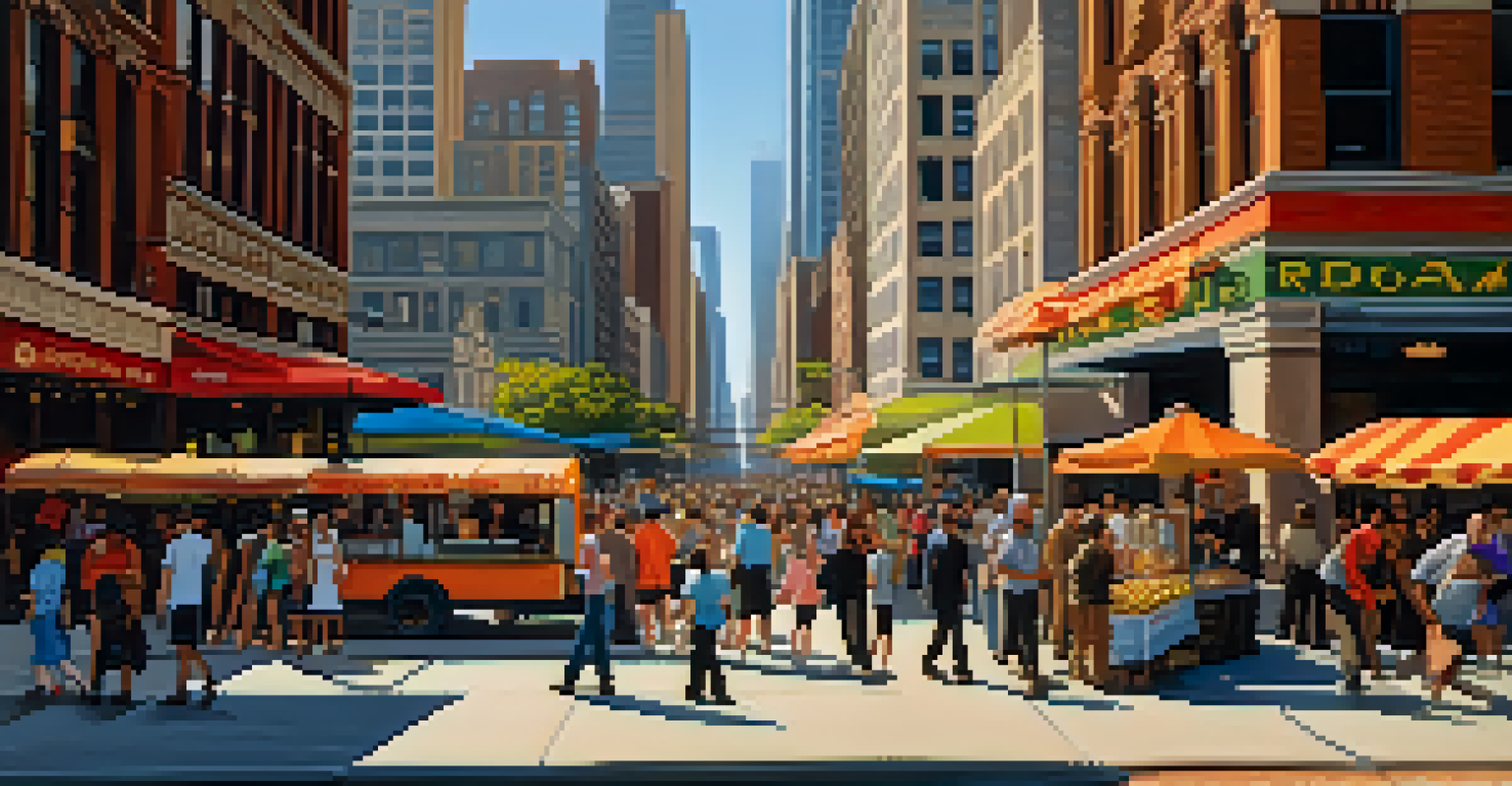Chicago as a Character: The City in Film Narratives

The Role of Chicago in Film History
Chicago has a storied history in cinema, serving as a backdrop for countless films. From classic noir to modern dramas, the city’s architecture and vibrant street life add depth to the narratives. Filmmakers often choose Chicago not just for its skyline, but for the emotions it evokes, making it a character in its own right.
In a city like Chicago, you can’t help but feel the weight of history and the pulse of modern life intertwined.
Consider the iconic film 'Chicago' (2002), where the city’s jazz age and corruption are intertwined with the plot, showcasing its rich cultural history. The film uses Chicago’s distinct neighborhoods to highlight the contrasts between wealth and poverty, making the city integral to the story. This relationship exemplifies how a setting can enhance character arcs and plot dynamics.
Moreover, films like 'The Dark Knight' (2008) utilize the city’s gritty atmosphere to amplify tension and drama. The Chicago skyline becomes a canvas for Batman’s battles, transforming the city into a living, breathing character that influences the story. In this way, filmmakers harness the essence of Chicago, making it more than just a location.
Architecture: A Silent Storyteller
Chicago's architecture plays a pivotal role in shaping the narratives within films. The unique blend of historical and modern buildings creates a dramatic backdrop that enhances storytelling. For instance, the towering skyscrapers symbolize ambition and danger in many crime dramas, reflecting the internal struggles of the characters.

In films like 'Transformers: Dark of the Moon' (2011), the cityscape is not merely a setting; it’s a vital part of the action. As the Autobots and Decepticons battle over Chicago, the city’s architecture is manipulated to heighten the stakes. This interplay between the city and the plot demonstrates how the physical environment can influence character decisions and outcomes.
Chicago: A Cinematic Character
Chicago's unique architecture and vibrant culture not only serve as a backdrop but also become integral to film narratives.
Furthermore, the use of specific neighborhoods, like the historic districts and industrial zones, adds layers to character development. Each location tells its own story, often mirroring the protagonist's journey. This architectural storytelling makes Chicago a rich tapestry that filmmakers can weave into their narratives.
Cultural Identity and Representation
Chicago is a melting pot of cultures, and this diversity is often reflected in its portrayal in film. Movies like 'Love Jones' (1997) showcase the city’s vibrant African-American culture, highlighting the relationships and struggles within this community. This cultural representation adds authenticity and depth, making Chicago a character that resonates with audiences.
Chicago is a city of neighborhoods, each with its own story to tell, contributing to the greater narrative of the city itself.
The city’s festivals and events, such as the Chicago Blues Festival, are frequently depicted in films, enriching the narrative with local flavor. When characters engage in these cultural activities, the audience gets a taste of Chicago’s soul, making the city an integral part of their journey. This cultural context helps viewers connect more deeply with the characters.
Moreover, films often explore social issues relevant to Chicago, such as segregation and economic disparity. By addressing these themes, filmmakers create a dialogue about the city’s challenges, using its identity as a character to drive the narrative forward. This engagement with real-world issues adds layers to both the city and the film.
The City as a Reflection of Characters
In many films, Chicago mirrors the inner lives of characters, acting as a reflection of their struggles and triumphs. For example, in 'The Fugitive' (1993), Dr. Richard Kimble’s frantic search through the city symbolizes his quest for truth and justice. The bustling streets and hidden alleyways represent the obstacles he must overcome.
The emotional landscape of Chicago often aligns with character arcs; the city’s weather, from harsh winters to vibrant summers, can echo a character’s mood. In 'The Break-Up' (2006), the changing seasons reflect the ups and downs of the couple’s relationship, making Chicago a partner in their story. This connection adds an emotional depth that resonates with viewers.
Cultural Identity in Film
The city's diverse cultural landscape is often depicted in films, adding authenticity and depth to character experiences.
Additionally, the idea of the city as a character allows for a more immersive experience. When audiences see characters navigating familiar Chicago landmarks, they feel a deeper connection to both the story and the setting. This synergy between character and city creates a powerful narrative experience.
Chicago in the Crime Genre
Chicago has long been associated with the crime genre, becoming a character that embodies danger and intrigue. Films like 'The Untouchables' (1987) and 'Chicago Fire' (2012) explore the city’s notorious history of organized crime. The gritty streets and dark alleys set the stage for thrilling narratives, making Chicago a perfect backdrop for such stories.
The city’s rich criminal history often informs the characters’ motivations and actions. In 'Public Enemies' (2009), the portrayal of John Dillinger and the FBI’s pursuit highlights the tension between law and crime, with Chicago serving as the battleground. This historical context enriches the narrative and elevates the city’s role in the film.
Moreover, the blend of real-life events and fictional stories has given Chicago a unique identity within the crime genre. The city’s reputation for corruption and violence often leads to compelling character conflicts, driving the plot forward. This synergy between narrative and setting makes Chicago an iconic character in its own right.
Chicago's Influence on Independent Films
Chicago’s indie film scene has flourished in recent years, showcasing the city as a character in unique and innovative ways. Independent filmmakers often highlight lesser-known neighborhoods, giving audiences a fresh perspective on the city. These films provide a more intimate look at Chicago, focusing on personal stories that resonate deeply with viewers.
For instance, films like 'The Road to the Altar' (2013) explore themes of love and community within the context of Chicago’s diverse neighborhoods. By placing characters in familiar yet nuanced settings, filmmakers create a rich tapestry that reflects the city’s complexity. This approach allows Chicago to become a character that embodies the film's heart.
Chicago's Crime Genre Legacy
The city's notorious history and gritty streets make it a compelling setting for crime dramas, enriching the storytelling experience.
Furthermore, the DIY spirit of indie filmmaking often mirrors the resilience of Chicago itself. Characters in these films often face obstacles similar to those encountered by the city’s residents, creating a relatable narrative. This connection deepens the viewer’s emotional investment, as they witness both the characters and the city navigate their challenges.
Conclusion: Chicago's Enduring Legacy in Film
The city of Chicago has cemented its legacy as a character in film narratives across genres. Its rich history, diverse culture, and unique architecture provide filmmakers with a dynamic canvas to tell their stories. From crime dramas to romantic comedies, Chicago’s essence is woven into the fabric of countless films.
As audiences continue to engage with these cinematic portrayals, they develop a deeper understanding of the city’s identity. Chicago becomes not just a setting, but a living, breathing character that shapes and is shaped by the narratives it inhabits. This enduring relationship between film and the city enhances the viewing experience, drawing audiences into its world.

Ultimately, Chicago’s role in film reflects the complexities of urban life, making it a character that resonates with viewers on multiple levels. As filmmakers continue to explore the city’s multifaceted identity, Chicago will undoubtedly remain a beloved character in cinematic storytelling for years to come.